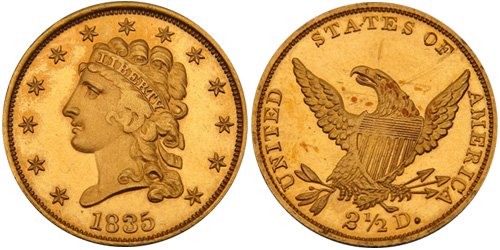Guide to U.S. Classic Head Quarter Eagles
The Classic Head Quarter Eagles struck from 1834 to 1839 represented a short-lived but important series for the $2.50 gold denomination. This was the first series for the denomination to meaningfully circulate, supported by fairly robust production at the Philadelphia Mint. In 1838 production would take place at the Charlotte Mint, representing the first time the denomination would be struck at a branch mint. In 1839, production would also take place at the branch mints located in Dahlonega and New Orleans. The following year a new design would be adopted, putting an end to this series struck at a turning point for American gold coinage.

In the early 19th century, the production of quarter eagles had been extremely sparse, and the pieces were virtually unseen in circulation. The value of the denomination was too high for domestic use within commerce and too low for exportation purposes, leading to limited demand. Additionally, at various times the value of the gold exceeded the $2.50 face value, leading quantities to be melted soon after their mintage. The situation would change after the passage of the Coinage Act of 1834, which reset the value of gold in relation to the dollar by reducing the gold content for each denomination.
A new design was created for quarter eagles struck under the revised specifications to distinguish from the earlier issues. This consisted of a new obverse portrait and a modified reverse design created by William Kneass, the second Chief Engraver of the United States Mint.
The obverse of the Classic Head Quarter Eagle features the head of Liberty, facing left. She is much younger in appearance compared to the previous type, with her hair in bumpy curls bound by a ribbon bearing the word LIBERTY. The portrait is surrounded by thirteen stars with the date placed below. The reverse design is similar to the previous type, featuring an eagle with a shield at its breast and talons grasping an olive branch and three arrows. The inscriptions UNITED STATES OF AMERICA and 2 1/2 D. appear surrounding. The scroll containing the motto E PLURIBUS UNUM which had appeared on the previous type is no longer present.
With the introduction of the new design and specifications, production for the denomination would rise dramatically from previous levels. The Philadelphia Mint produced more than 100,000 pieces for each of the first two years of the series, followed by more than half a million pieces in the third year. Production at the Philadelphia Mint would decline somewhat for the final three years of the series, creating slightly scarcer dates. In addition to business strikes, the Philadelphia Mint produced a small number of proof coins each year, which are all extremely rare and seldom available.
In 1838 and 1839, production also took place at the recently established branch mints. The Charlotte and Dahlonega Mints were located in gold rush areas and served the production needs for gold coins, while the New Orleans Mint struck both gold and silver coins. In 1838, only the Charlotte Mint produced quarter eagles with only 7,880 struck, representing the lowest mintage for the series. In 1839, the Dahlonega and New Orleans Mints produced quarter eagles for the first time. All of the branch mint issues circulated extensively, making them the most difficult coins of the series to acquire in uncirculated condition.

